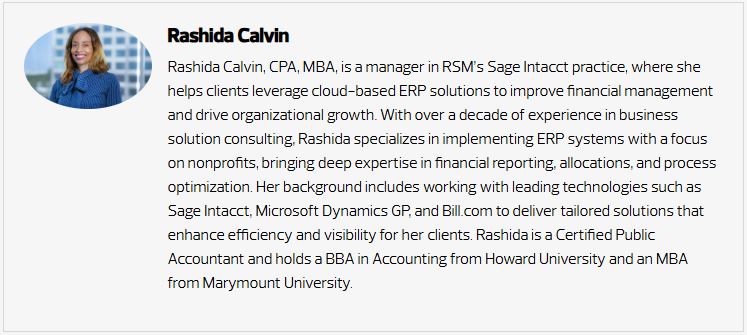Healthcare organizations currently encounter numerous challenges that can hinder their operational efficiency and financial performance. For instance, factors such as inflation, labor force fluctuations, and complex regulatory requirements can affect their ability to deliver quality care while remaining profitable. However, advanced technology solutions like Sage Intacct provide a means to tackle these issues by streamlining processes, enhancing data visibility, and improving decision-making capabilities. Specifically, this cloud-based financial management software offers strong functionalities for transaction allocations, journal entries, and real-time reporting. Consequently, this enables healthcare organizations to achieve higher financial accuracy and efficiency. This blog examines how Sage Intacct dashboards can be utilized to enhance healthcare decision-making and drive operational excellence.
Optimizing Healthcare with Sage Intacct Dashboards
Comprehensive Dashboard Functionality
Implementing Sage Intacct brings considerable benefits to healthcare organizations, especially through its extensive dashboard functionality. For example, these dashboards offer a complete view of key performance indicators (KPIs) and financial metrics, allowing healthcare leaders to make informed decisions quickly. Moreover, they are customizable to show performance cards, financial reports, graphs, and memorized reports, the dashboards provide access to real-time data. As a result, this ensures stakeholders can monitor organizational health and swiftly respond to changes, which is crucial for identifying trends, assessing departmental performance, and optimizing resource allocation.
Multi-Dimensional Reporting
Sage Intacct’s integration of multiple dimensions into its reporting framework is a major advantage. Unlike traditional systems that depend on complex account strings, Sage Intacct allows users to tag transactions with various dimensions such as location, department, project, and class. This flexibility simplifies data entry and enhances reporting accuracy. Healthcare organizations can filter and analyze data based on these dimensions, providing deeper insights into financial performance and operational efficiency. For instance, a CFO can promptly evaluate profitability trends across different locations, while a department manager can delve into budget variances to pinpoint areas for improvement.
The role-based dashboard feature further enhances Sage Intacct’s utility by customizing data presentation to meet the needs of various users within the organization. Financial leaders can access higher-level summaries and trend analyses, while department managers can view detailed budget versus actual reports and delve into specific transactions. This targeted approach makes sure that each user has access to relevant information, promoting better decision-making and accountability. Office managers can filter dashboards by location to monitor performance and manage resources effectively.
Sage Intacct categorizes its dimensions into standard, user-defined, and specialty dimensions, creating a comprehensive framework for tracking and analyzing transactions. Standard dimensions include customer, vendor, employee, department, location, class, item, and project. User-defined dimensions allow organizations to create custom fields tailored to their particular needs, while specialty dimensions such as project, warehouse, and contract offer additional granularity for complex reporting demands. This multi-dimensional approach allows healthcare organizations to capture and analyze data from various perspectives, supporting strategic planning and operational optimization.
Enhancing Expense Management with Sage Intacct
Transaction Allocation and Journal Entries
Sage Intacct’s transaction allocation feature transforms expense management for businesses with multiple locations or departments. Specifically, this functionality allows for precise distribution of expenses across sub-locations or departments based on predefined percentages. For instance, a dental practice can evenly allocate expenses across its branches, ensuring each location bears its fair share of costs. Consequently, this streamlines the accounting process and boosts transparency and accountability within the organization. Furthermore, adjustments are easily made to keep total allocations always summed to 100%, maintaining accuracy in financial reporting.
Creating journal entries in Sage Intacct is uncomplicated and integrates seamlessly with transaction allocations. Users can input detailed descriptions, reference numbers, and attach relevant documents such as receipts directly to the journal entry. This feature is especially useful for keeping comprehensive records and aiding audits. The capability to allocate expenses to multiple locations within a single journal entry reduces manual data entry and minimizes errors. Sage Intacct supports multiple lines in a transaction, catering to complex accounting needs and ensuring accurate recording of all financial activities.
Real-Time Reporting and Non-Financial Data Tracking
Real-Time Reporting
Real-time reporting and dashboards are among Sage Intacct’s most powerful features. Once transactions are posted, they are immediately reflected in the system’s dashboards, providing instant insights into the organization’s financial health. These dashboards can be customized to emphasize specific metrics relevant to different departments or locations. For instance, a dental practice can track patient counts, dentist counts, and other operational metrics alongside financial data. The ability to delve into specific line items and view detailed reports boosts decision-making capabilities, allowing managers to respond quickly to financial trends and anomalies.
Non-Financial Data Tracking
Sage Intacct also supports non-financial data tracking through statistical accounts. This feature allows businesses to monitor various metrics such as headcount, meals served, or square footage, which are essential for operational planning and performance analysis. Statistical journal entries can be created similarly to financial entries, with the added flexibility of not needing balanced entries. This allows accurate tracking of non-financial data that can be integrated into dashboards for a complete view of the organization’s performance. The real-time update of dashboards ensures managers have access to the latest data, facilitating informed decision-making.
Healthcare organizations can substantially benefit from implementing Sage Intacct to tackle their operational and financial challenges. Notably, the platform’s advanced dashboard functionality, multi-dimensional reporting capabilities, and role-based data presentation provide a powerful tool for enhancing visibility, improving decision-making, and optimizing resource allocation. By leveraging these features, healthcare leaders can navigate the industry’s complexities, drive efficiency, and ultimately deliver better care to their patients. Therefore, investing in technology solutions like Sage Intacct is a strategic move that can bridge the gap between current challenges and future success.
Sage Intacct offers a versatile and scalable solution for businesses looking to improve their financial management processes. Its transaction allocation, journal entry, and real-time reporting features streamline accounting tasks, reduce errors, and provide valuable insights into both financial and non-financial metrics. By utilizing Sage Intacct, businesses can achieve higher efficiency, accuracy, and transparency in their financial operations, ultimately driving better business outcomes.
Co-written by Rashida Calvin and Sydney Cohen.

 RSMUS.com
RSMUS.com




